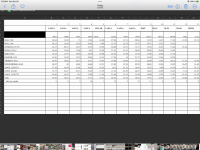To clarify, you're not going to see earth-shattering differences between 50 yards and 60 yards, but the point is that what you get at either distance is not going to be a directly-relatable amount. It's going to depend on what distance the gun is tuned for versus the distance you're shooting at. In most instances, rimfire benchrest competitions are shot at 50 yards, so it makes sense to test at 50 yards. You're going to want that gun to be tuned for 50 yards if that's where your competition distance is, and playing at other distances won't tell you as much as you want to know about 50 yards. Multiplying by 5/6 is correct as far as translating one size at 60 yards to what it would be at 50 yards *if* it shot the same at 50 yards. And I'm just trying to point out that it isn't going to shoot the same at 50 yards. Again, it isn't going to be 1" at 50 yards and 10" at 60 yards, as we are only talking about a 10-yard difference, but it isn't going to be exactly 5/6ths when you go from 60 down to 50 because there is also going to be a small difference in how it shoots at both distances. You're not going to learn nothing at 60 yards, but you will be better off to just pace off 10 yards closer and temporarily put a target holder there at 50 yards. In most scenarios you might not care all that much, but when you're talking about getting serious with serious bench guns, you're better off actually shooting at 50.







































































